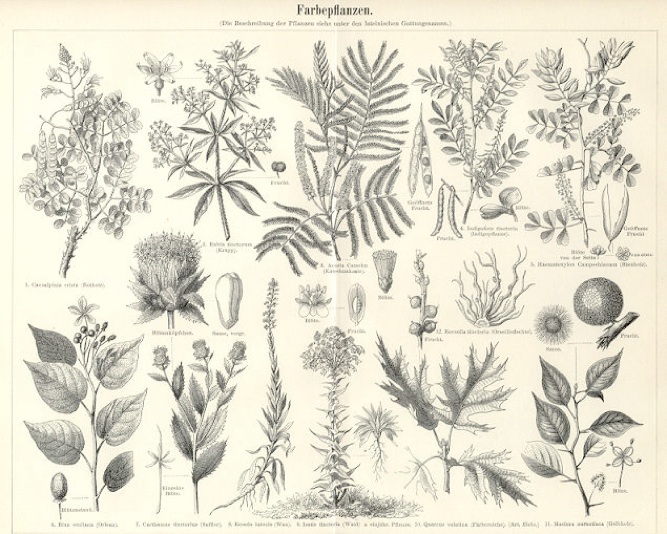Botanical Dyes

NATURAL DYE PLANTS, FARBEPFLANZEN , 1894 Botanical Antique Print
Natural dyes are made by collecting plant materials (flowers, twigs, leaves, bark, roots), chopping or breaking them into small pieces, and then slowly boiling them. The dye produced is then strained, acidified with vinegar (except for onion skins), and stored in a refrigerator until needed. Natural dyes do not last as long as chemical ones, often only a week or two, and must be produced nearer to the time they are needed.
The color of a plant sometimes, but not always, predicts the color of dye it will produce. Lilac blossoms, for instance, will produce an “off-green” or yellow dye; most flowers, actually, produce yellow or red dyes, not withstanding the color of their petals.
Various parts of the plants can be used–roots, leaves, and flowers are used most commonly, but twigs and barks can also be utilized. Different parts of the plant can even yield different colors. Dried materials can be used to produce dyes, but fresh plants often produce much more vivid dyes.
How do you make dyes? There are two main variants.
Hot Water Dye: The first (and quickest) is a hot-water bath dye, which is not useful for pysanky, as the hot water will boil the egg and melt off the wax. It can be used for krashanky, though, or for lystovanky (Pace eggs):
-
1.Collect the dye material.
-
2.Wash the material thoroughly in warm water and pick out any foreign matter.
-
3.Finely chop or break the material into small pieces. The amount used will determine the depth of the shade produced. While raw material vary greatly, a generous handful per cup of water will usually suffice.
-
4.Place the material into a pot, and add just enough water to cover it. Use a glass or wooden stirrer (not metal).
-
5.Add eggs to the pan. Leave some space between them.
-
6.Bring the water to a boil, then educe the heat and let the solution simmer for 15 to 20 minutes. Remove the eggs and rinse them.
Cold Water Dye: To create pysanky, we need prepared dyes that will work at room temperature. Cooking pysanky will not only destroy their magic powers, but will melt off the wax prematurely and damage the cuticle of the shell. To make natural dyes for pysanky:
-
1.Collect the dye material.
-
2.Wash the material thoroughly in warm water and pick out any foreign matter.
-
3.Finely chop or break the material into small pieces. The amount used will determine the depth of the shade produced. While raw material vary greatly, a generous handful per cup of water will usually suffice.
-
4.Place the material into a pot, and add just enough water to cover it. Use a glass or wooden stirrer (not metal).
-
5.Heat the mixture to a low boil, and then cook until the water reaches the desired color. (This will take some trial and error on your part.) is could take anywhere from a few minutes to an hour, depending on the material being used and the shade you want. Keep in mind that the color of the eggs will be much lighter than the color of the dye solution.
-
6.Strain the mixture, after it has cooled, though a cheesecloth or fine sieve into another container. Add a tablespoon or two of white vinegar (except for onion skins).
-
7.Store in the refrigerator in a closed glass container until needed. (The dye may stain plastic containers.) When dyeing, you will need to bring the dye back to room temperature before using.
Use these dyes as you would the chemical dyes, following the same procedures (clean, room temperature eggs, etc.). Keep in mind that dyeing times will be quite different, and could be much, much longer.
Try them out and see what you get. If you have had experience with natural dyes, have tried any of the dyes above, or have suggestions for dyes and/or recipes, please e-mail me at the link below.
Note: These recipes have been taken from Rhonda M. Hart’s “Easter Eggs by the Dozens!”
Back to Main Dyes page
Back to MAIN Pysanka home page.
Back to Pysanka Index.
Search my site with Google
Botanical Dyes




